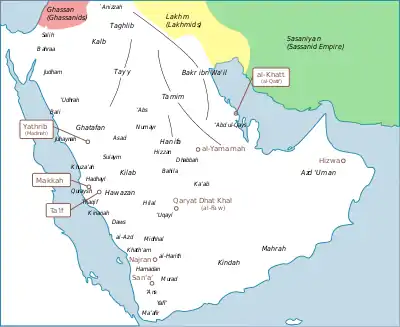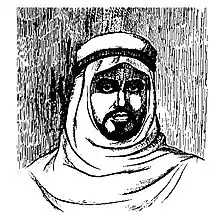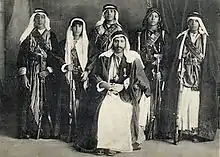Anazzah
Anezzah (Arabic: عنزة, Anezzah) is an Arabian tribe in the Arabian Peninsula, Upper Mesopotamia, and the Levant. it is estimated that the tribe of Anezzah Has about 22 - 25 million Arabs Traced back to it making it the most populated Tribe in Arabia.

Diyarbakir is a city in Southern Turkey it is named after Bakr Ibn Wa’il the name Diyarbakir translates to the Land of Banu Bakr Ibn Wa’il which is a branch of the tribe Anezzah.
Genealogy and origins
Anazzah's existence as an autonomous tribal group, like many prominent modern tribes, predates the rise of Islam in the 7th century CE. The classical Arab genealogists placed `Anizzah within the large Rabi`ah branch of Adnanite (North Arabian) tribes, alongside the tribes of Abdul Qays, Bakr ibn Wa'il, Bani Hanifa, and Taghlib. In the genealogical scheme, `Anazzah's eponymous ancestor is a great uncle of all of these.
Two main branches of `Anazzah are recorded by the early Muslim scholars. One branch was nomadic, living in the northern Arabian steppes bordering Syria and Mesopotamia. The other, known as Bani Hizzan, was sedentary, living within the wadis of the district of Al-Yamama in eastern Nejd, just south of their purported cousins, the Bani Hanifa of the Bakr ibn Wa'il, who inhabited modern-day Riyadh. Families tracing their origin to `Annizah through Hizzan still exist in that area today.[1]
The other tribes of Rabi'ah were far more prominent in the events of late pre-Islamic Arabia and the early Islamic era (see Banu Hanifa, Taghlib, and Bakr). According to historians such as Al-Tabari (10th century CE), `Anazzah joined with Bakr ibn Wa'il under an alliance they called "al-Lahazim". Many of these tribes were followers of the Christian faith prior to Islam. Others such as bani Taghlib remained largely Christian even after the Islamic conquest of Mesopotamia and the Levant
Modern history

Anezzah in the 18th Century Sheikh Mashaan Ibn Hathal Was a Brave 18th century cavalier, Leader, and Poet who gained his fame From leading the Tribe of Anezzah across the Arabian peninsula and unifying it against the Tribe's Enemy's at the battle of Al Shimasiyah which happened in 1824/1825. Sheikh Mashaan died an honourable death in the battle of Al Shimasiyah but nevertheless they won the battle
`Annazah in Syria and Upper Mesopotamia

The modern tribe of `Annazah became prominent in the Ottoman era, as masters of the oasis towns of northwestern Arabia, particularly Khaybar and AlUla. Although not farmers themselves, the `Annizah levied crops from the inhabitants, and only spent the winter months in the area, while migrating northwards into southern Syria in the summer months, where they collected tribute from the inhabitants of the Hawran region. The tribute was known as khuwwa ("brotherhood"), and in exchange, the tribesmen pledged to protect the farmers from other tribes. Other clans of the tribe spread across the northern Arabian steppes as far north and east as the Euphrates. According to Encyclopedia of Islam, "it is not known whence they came", while many such as the Western travelers Philby and Anne Blunt simply assumed they had recently migrated from Nejd, having been pushed northwards into Syria by other tribes. However, the tribe does not appear in the historical or genealogical records of Nejd, and members of the tribe posit a migration from Syria and Iraq southwards to Nejd, which comports with the original lands of the Bakr ibn Wa'il. In particular, it is believed they originated from the area of Ayn Tamr in the Iraqi desert near Karbala. In the 19th century, the Swiss traveler Burckhardt and the British traveler Doughty visited the tribe in their stronghold of Khaybar and gathered from them many details of Bedouin life. Sheikh Medjuel el Mezrab of the Anizah was the husband of Lady Jane Digby.
One branch of the `Annizah in that area, centered around Al-Jouf and the valley of Wadi Sarhan and extending into Jordan and Syria, became so large and powerful that it practically developed into an independent tribe, known as the Ruwallah. The Ruwallah engaged in battle with other branches of `Annizah, and also became the arch-enemy of the large tribe of Shammar, who inhabited roughly the same area and dominated Nejd in the late 19th century after temporarily deposing the Al Saud. A 19th century oral poetic epic telling the tale of a rivalry between two heroes from Shammar and `Annizah was published in 1992.[2] The Ruwallah were among the tribes that took part in the "Arab Revolt" against the Ottomans in 1916. Another northern branch of `Annizah, the `Amarat, was centered in the deserts of Iraq.
According to the tribe's genealogists, the modern tribe in north Arabia is divided into the following branches:
- Dhana Bishr ("children of Bishr") – which includes the `Amarat of Arabia
——————
- Dhana Maslam – which includes the Ruwallah of north Arabia.
`Annazah in Nejd
The sparse chronicles of Nejd relating to the pre-Wahhabi era relate a process of penetration of the tribe into northern and western Nejd, where they began to claim pastures during the winter months.[3] One 19th-century historian, Ibn La'bun, a descendant of `Annizah who went by the tribal appellation of "Al-Wa'ili", recorded the story of the settlement of several `Annizi families in Nejd, which he placed in the 14th century CE. In the 15th century, the region of Al-Qassim in northern Nejd was being rapidly settled through migration and the majority of this activity was by members of `Annizah. In the early 18th century the Bedouins of `Annizah are recorded to have reached as far as the gates of Riyadh, killing its ruler in battle. This battle was part of a tribal war in which Riyadh and its neighboring villages took sides.
With the rise of the First Saudi State in the late 18th century, `Annizah were among the tribes that adopted a favorable attitude towards this new power, but took little active part in supporting it militarily, due to their geographical location. The royal family of Saudi Arabia Al Saud family are the from the 'Annizah tribe,[4] with Al Saud having ancestry from Wa'il, the region's native inhabitants as well as the migratory `Annizah. The Saud intermarried with their 'Annizah rivals, al Shammar, along with other powerful tribes to solidify their dynasty. Ibn Saud sired dozens of children by his many wives. He had at most four wives at a time, divorcing many times, making sure to marry into many of the noble clans and tribes within his territory, including the chiefs of the Bani Khalid, Ajman, and Shammar tribes, as well as the Al ash-Sheikh.[5]
20th century
Limited settlement of Bedouin tribesmen in nearby towns and villages has always been an ongoing process in the region. Settled families in `Annizah are to be found not only in Saudi Arabia, where they are most numerous, but also in Kuwait, Jordan, Iraq, Syria, Lebanon, United Arab Emirates, Qatar, Oman, Bahrain, Ahwaz (Iran) and the West Bank, where the village of Anzah near Jenin is reportedly named after the tribe.
The establishment of the modern borders of the Middle East dealt a severe blow to the Bedouin lifestyle of tribes such as `Annizah, which were accustomed to raising their animals over wide areas spanning many modern states. Special arrangements were made in the early 20th century for these tribes, but the vast majority ended up settling within these new states and taking Saudi, Kuwaiti, Iraqi, Lebanese, Syrian, or Jordanian citizenship. These recently settled tribesman are often distinguished from their sedentary cousins by retaining tribal appellations such as al-`Annizi or Al-Ruwaili as their surnames.
Notable people
Among the tribe's members are:
- Imam Ahmad Ibn Hanbal an Arab Muslim jurist, theologian, ascetic, hadith traditionist, and founder of the Hanbali school of Sunni jurisprudence — one of the four major orthodox legal schools of Islam
- Al-Qarid Al-Anzi chieftain of the Rabi`ah tribes
- Rabi` ibn Al-Afkal commander in the Rashidun Caliphate period
- Yahya ibn ʿUmar Al-Anzi was a military leader of the Abbasid Caliphate
- Harith al-Muhasibi founder of the Baghdad School of Islamic philosophy
- Abu-l-'Atahiya Classical poet
- Safaq Al-Anzi Saudi shooter
- Mohammed Salem Al-Anzi Qatari football player
- Ibn La'bun historian
- Abu Saeed bin Al-Arabi Sufi Master And Imam of al-Masjid al-Haram
References
- Hamad Al-Jassir, "Hizzan", Compendium of the Lineages of the Settled Families of Nejd, pt. II, p. 889 (Arabic)
- The social context of pre-Islamic poetry: poetic imagery
- U.M. Al-Juhany, Najd before the Salafi Reform Movement, Ithaca Press, 2002
- C.M. Doughty, Travels in Arabia Deserta
- "Role of Ikhwan in Early Saudi State"
Further reading
- De Gaury, Gerald. Review of the 'Anizah Tribe. Kutub. ISBN 9953-417-97-0.
- Robinson, E.; Smith, E. (1841). Biblical Researches in Palestine, Mount Sinai and Arabia Petraea: A Journal of Travels in the year 1838. 2. Boston: Crocker & Brewster. (p. 584 ff)